小学二年级英语语法讲解【三篇】
小学二年级的英语的语法学习知识点归纳.docx

二年级英语的语法知识点归纳二年级英语的语法知识点归纳1:宾语一、名词作宾语Show your passport, please.请出示护照。
二、代词作宾语He didn't say anything.他什么也没说。
三、数词作宾语How many do you want? - I want two.你要几个 ?- 我要两个。
四、名词化的形容词作宾语They sent the injured to hospital.他们把伤员送到医院。
五、不定式或ing 形式作宾语They asked to see my passport.他们要求看我的护照。
I enjoy working with you.我和你们一道工作很愉快。
六、从句作宾语Did you write down what he said?你把他的话记下了没有?二年级英语的语法知识点归纳2:名词一、定义名词是表示人或事物名称的词。
它既可以表示具体的东西,也可以是表示抽象的东西。
二、分类1.名词可以根据意义分为普通名词和专有名词如: John is a studentstudent 是普通名词, John 是专有名词普通名词前可以用不定冠词a/an, 定冠词 the 或不加冠词,专有名词前一般不加冠词,专有名词的首字母要大写。
2.普通名词又可以分为个体名词、集体名词、物质名词和抽象名词,其中个体名词与集体名词是可数名词,物质名词和抽象名称是不可数名词。
3.专有名词专有名词是表示人名、地名、团体、机构、组织等的专有名词,多为独一无二的事物。
三、名词的数1、名词分为可数名词和不可数名词。
可数名词 —— 可以数的名词不可数名词 —— 数不清 (没有复数 )Drink?milk tea water orange juice coke coffee porridgeFood?rice bread meat fish fruit cake dumplings2、可数名词与不定冠词a(an)连用有数数形式,不可数名词不能与不定冠词a(an)连用,没有复数形式many+可数名词复数much/a little+ 不可数名词some, any , a lot of (lots of)两者都可以修饰。
小学二年级英语语法归纳总结
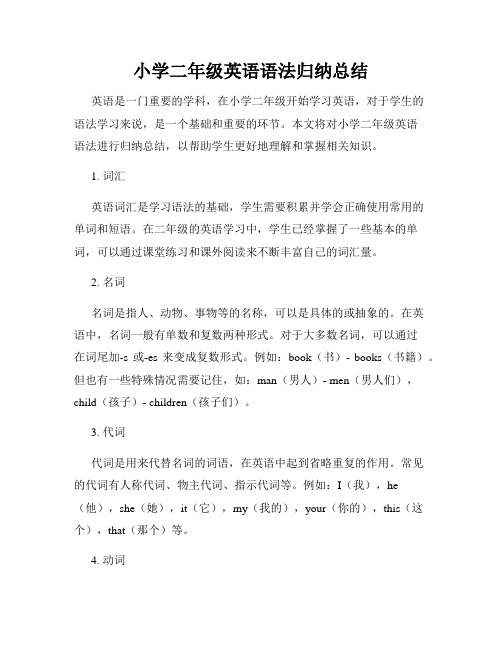
小学二年级英语语法归纳总结英语是一门重要的学科,在小学二年级开始学习英语,对于学生的语法学习来说,是一个基础和重要的环节。
本文将对小学二年级英语语法进行归纳总结,以帮助学生更好地理解和掌握相关知识。
1. 词汇英语词汇是学习语法的基础,学生需要积累并学会正确使用常用的单词和短语。
在二年级的英语学习中,学生已经掌握了一些基本的单词,可以通过课堂练习和课外阅读来不断丰富自己的词汇量。
2. 名词名词是指人、动物、事物等的名称,可以是具体的或抽象的。
在英语中,名词一般有单数和复数两种形式。
对于大多数名词,可以通过在词尾加-s或-es来变成复数形式。
例如:book(书)- books(书籍)。
但也有一些特殊情况需要记住,如:man(男人)- men(男人们),child(孩子)- children(孩子们)。
3. 代词代词是用来代替名词的词语,在英语中起到省略重复的作用。
常见的代词有人称代词、物主代词、指示代词等。
例如:I(我),he (他),she(她),it(它),my(我的),your(你的),this(这个),that(那个)等。
4. 动词动词是表示动作、状态或事情发生的词语,是句子的核心。
在动词的时态方面,小学二年级主要学习一般现在时和一般过去时。
一般现在时表示经常性的动作或现在的状态,一般过去时表示过去发生的动作或状态。
一般现在时的肯定句结构:主语 + 动词原形 + 其他。
例如:I play basketball with my friends.一般过去时的肯定句结构:主语 + 动词过去式 + 其他。
例如:They watched a movie yesterday.5. 形容词形容词是用来描述名词的特征或性质的词语,可以帮助学生更加形象地表达事物。
形容词在句中通常位于名词之前。
例如:a big house(一座大房子),a beautiful flower(一朵漂亮的花)。
6. 副词副词是修饰动词、形容词和其他副词的词语,可以表达时间、地点、方式等。
小学二年级英语语法知识点

小学二年级英语语法知识点【篇一】小学二年级英语语法知识点名词复数规则:1、一般情况下,直接加-s如:book-books, bag-bags, cat-cats, bed-beds2、以s. x. sh. ch结尾,加-es如:bus-buses, box-boxes, brush-brushes, watch-watches3、以“辅音字母+y”结尾,变y为i, 再加-es如:family-families, strawberry-strawberries4、以“f或fe”结尾,变f或fe为v, 再加-es如:knife-knives, wife-wives5、不规则名词复数:man-men, woman-women, policeman-policemen, policewoman-policewomen,mouse-mice, child-children, foot-feet, tooth-teeth, fish-fish, people-peopleChinese-Chinese, Japanese-Japanese【篇二】小学二年级英语语法知识点1、What can you do? I can sing.2、What is that in the net ? It’s a mouse.3、What can you see? I can a net .4、What can you see , Tom? I can see a bee.5、What colour is your pencil case? It’s blue.6、What’s this? It’s an apple.7、What’s on the desk? There are books.8、What’s in your room? There is a bed in my room.9、What’s your name? My name is Xiao jia.10、What’s on your desk? The book on my desk.11、What colour is your bag? It is pink.12、What’s that in your hand? It is pencil.13、What animal do you like? I like monkey and zebra.14、What dose it like? It likes to eat fish.15、How are you? I’m fine . Thank you.16、How are you today? I’m very well.Thank you.17、How is the weather? It’s windy.18、How old are you? I’m seven.19、How many chairs? There are seven chairs.20、How many spoons? There is one.【篇三】小学二年级英语语法知识点人称主格宾格形容词名词性第一人称单数 I me my mine myself复数 we us our ours ourselves第二人称单数 you you your yours yourself复数 you you your yours yourselves第三人称单数 she her her hers herselfhe him his his himselfit it its its this that itself复数 they them their theirs these those themselves 【篇四】小学二年级英语语法知识点一般现在时:通常用“usually, often, every day, sometimes”。
英语小学生二年级的语法大全
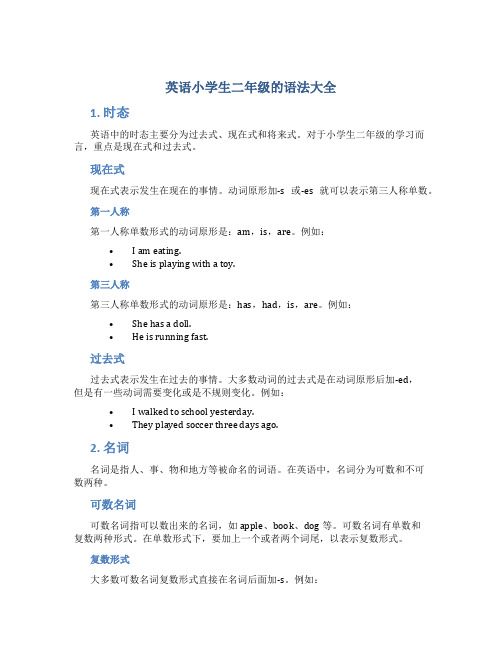
英语小学生二年级的语法大全1. 时态英语中的时态主要分为过去式、现在式和将来式。
对于小学生二年级的学习而言,重点是现在式和过去式。
现在式现在式表示发生在现在的事情。
动词原形加-s或-es就可以表示第三人称单数。
第一人称第一人称单数形式的动词原形是:am,is,are。
例如:•I am eating.•She is playing with a toy.第三人称第三人称单数形式的动词原形是:has,had,is,are。
例如:•She has a doll.•He is running fast.过去式过去式表示发生在过去的事情。
大多数动词的过去式是在动词原形后加-ed,但是有一些动词需要变化或是不规则变化。
例如:•I walked to school yesterday.•They played soccer three days ago.2. 名词名词是指人、事、物和地方等被命名的词语。
在英语中,名词分为可数和不可数两种。
可数名词可数名词指可以数出来的名词,如apple、book、dog等。
可数名词有单数和复数两种形式。
在单数形式下,要加上一个或者两个词尾,以表示复数形式。
复数形式大多数可数名词复数形式直接在名词后面加-s。
例如:•I have two dogs.•They are eating apples.但是也有一些可数名词,需要在词尾进行变化:•变化以“s、x、ch、sh”结尾的词,在词尾添加-es。
•变化以“f、fe”结尾的名词,在词尾改变为-ves。
•一些词在复数形式时需要改变拼写,如man改为men。
不可数名词不可数名词指无法计数的名词,如water、rice、milk等。
因为无法计数,所以不可在名词前面加上数词。
如果需要表示数量,可以使用量词来表示。
3. 形容词形容词是指用于描述名词或代词的词语。
在英语语法中,形容词通常放在名词前面。
例如:•She is wearing a beautiful dress.•The black cat is sleeping.4. 副词副词是指用于修饰动词、形容词、其他副词和短语的词语。
二年级小学生的英语语法

二年级小学生的英语语法英语语法是学习英语的一个重要组成部分,而对于小学二年级的学生来说,基础的语法知识也是必不可少的。
在本篇文档中,将会对二年级小学生的英语语法进行简单介绍。
What is English Grammar?英语语法是指英语的语言规则,包括词汇、句子、短语、语法等方面。
学习英语语法能够帮助学生提高英语水平,更好地理解英语。
Parts of Speech英语词汇可以分为不同的词类,也称为“Parts of Speech”。
以下是几个二年级小学生需要掌握的基本词类:•Nouns(名词):指人、物、地方或概念等。
•Verbs(动词):表示动作、状态或感觉。
•Adjectives(形容词):用来描述一个名词。
•Adverbs(副词):用来描述动词、形容词或其他副词。
•Pronouns(代词):用来代替或替换名词。
•Prepositions(介词):用来描述名词与其他单词之间的关系。
•Conjunctions(连词):用来连接单词、短语或句子。
•Interjections(感叹词):用来表达惊讶、高兴或其他强烈的情绪。
Basic Sentence Structure英语句子的基本结构是主语+谓语。
主语是句子中的主要名词,而谓语则表示主语所做的动作或状态。
以下是几个例子:•The cat is sleeping. (猫正在睡觉。
)•Sally likes ice cream. (Sally喜欢冰淇淋。
)在以上例子中,“cat”和“Sally”是主语,而“is sleeping”和“likes”则是谓语。
Tenses英语动词的时态(Tenses)是表示动作发生时间的方式。
以下是如何使用几个常见的时态:•现在时(Present Tense):表示现在正在发生的事情。
例如:“I am eating breakfast.”(我正在吃早餐。
)•过去时(Past Tense):表示已经发生的过去事件。
例如:“I played basketball yesterday.”(昨天我打篮球了。
建议二年级学生记住的英语语法顺口溜
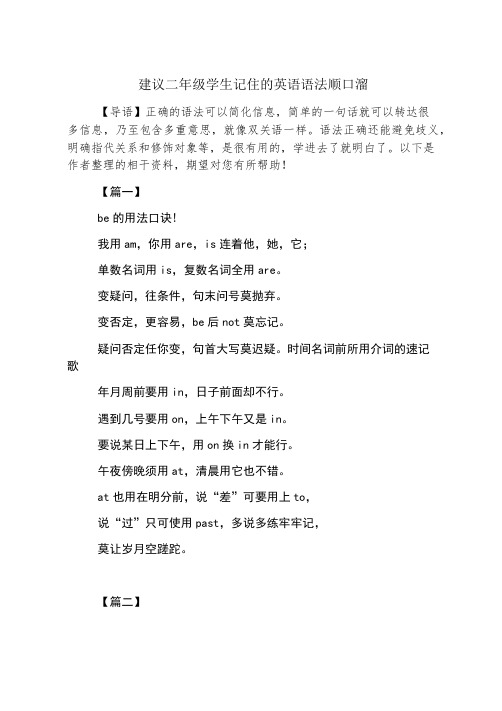
建议二年级学生记住的英语语法顺口溜【导语】正确的语法可以简化信息,简单的一句话就可以转达很多信息,乃至包含多重意思,就像双关语一样。
语法正确还能避免歧义,明确指代关系和修饰对象等,是很有用的,学进去了就明白了。
以下是作者整理的相干资料,期望对您有所帮助!【篇一】be的用法口诀!我用am,你用are,is连着他,她,它;单数名词用is,复数名词全用are。
变疑问,往条件,句末问号莫抛弃。
变否定,更容易,be后not莫忘记。
疑问否定任你变,句首大写莫迟疑。
时间名词前所用介词的速记歌年月周前要用in,日子前面却不行。
遇到几号要用on,上午下午又是in。
要说某日上下午,用on换in才能行。
午夜傍晚须用at,清晨用它也不错。
at也用在明分前,说“差”可要用上to,说“过”只可使用past,多说多练牢牢记,莫让岁月空蹉跎。
【篇二】记住f(e)结尾的名词复数妻子持刀去宰狼,小偷吓得发了慌;躲在架后保己命,半片树叶遮眼光。
A.taking awayB.being taken awayC.to take awayD.to be taken away巧记48个国际音标单元音共十二,四二六前中后。
双元音也好背,合口集中八个整。
辅音共计二十八,八对一清又七浊,四个连对也包括。
有气无声清辅音,有声无气浊辅音,发音特点应掌控。
【篇三】非谓语动词的一些特别用法后只接不定式作宾语的一些常用特别谓语动词动词后,不定式,want,hope和wish,agree,decide,mean,manage,promise,expect,pretend,且说两位算在此,要记牢,要记住,掌控它们靠自己。
后接动词不定式做宾语补足语省略不定式符号“to”的一些常用特别动词一些动词要掌控,have,let和make,此三动词是使役,“注意”“视察”“听到”see,还有feel和watch,使用它们要仔细,后接“宾补”略去“to”,此点千万要牢记除此之外,还可以掌控“八字言”,一感feel,二听hear,listento,三让have,let,make,四看see,lookat,observe,watch【篇四】后只接动名词做宾语的一些常用特别动词特别动词接“动名”,使用它们要记清,“舍弃”“享受”可“后悔”,“坚持”“练习”必“完成”,“延期”“避免”非“介意”掌控它们今必行。
最新小学二年级英语语法知识点三篇分享

小学二年级英语语法知识点三篇分享【导语】语法就是语言的规律。
任何一种语言都有其内在逻辑性(logic)和规律(discipline)。
学习一些基本的英语语法,对于快速掌握英语语言的规律,具有事半功倍的作用,尤其是对于一些为考试而编的语法题句的理解,很有作用。
以下是整理的相关资料,希望对您有所帮助!【篇一】语态有两种:主动语态和被动语态。
主语是动作的发出者为主动语态:主语是动作的接受者为被动语态。
1) 若宾语补足语是不带to 的不定式,变为被动语态时,该不定式前要加”to”。
此类动词为感官动词。
feel, hear, help, listen to, look at, make, observe, see, notice, watchThe teacher made me go out of the classroom。
--> I was made to go out of the classroom (by the teacher)。
We saw him play football on the playground。
--> He was seen to play football on the playground。
2) 情态动词+ be +过去分词,构成被动语态。
Coal can be used to produce electricity for agriculture and industry。
【篇二】(1) Basic form: am/are/is(2) 肯定和否定句 I am(not) from London.My eyes are(not) small.My hair is(not) long.(3)一般疑问句: Am I a Chniese? Yes, you are. No, you aren’t.Are they American? Yes, they are. No, they aren’t.Is the cat fat? Yes, it is. No, it isn’t. 【篇三】一、名词作主语David arrived last night.大卫昨晚到达。
英语语法句子结构讲解(精选6篇)

英语语法句子构造讲解〔精选6篇〕篇1:英语语法句子构造讲解在此句式中,V是不及物动词,又叫自动词(vi.)。
例如:He runs quickly.他跑得快。
They listened carefully.他们听得很仔细。
He suffered from cold and hunger.他挨冻受饿。
China belongs to the third world country.中国属于第三世界国家。
The gas has given out.煤气用完了。
My ink has run out.我的钢笔水用完了。
篇2:英语语法句子构造讲解在此句式中,V是及物动词(vt.),因此有宾语。
例如:I saw a film yesterday.我昨天篇3:英语语法-there be 句式构造讲解英语语法-there be 句式构造讲解there be构造中的主语一般皆指不确定的事物,不专指特定的.某一或某些事物,但有时也有例外,请看下面一些例证:Xu said there was no longer the variety of play in China as in his days.徐说中国已不再有他那个时代的那种打法(指乒乓球)了。
(指类型时可用定冠词the, 表特定)Many young people are taking radio courses in English. There is the boy next door, for exle.许多年轻人在学播送英语课程。
比方隔壁那个男孩就是。
(用the表特定事例)Then there’s Mrs. Green―she must be invited to the wedding.还有格林太太――必须邀请她参加婚礼。
(与then连用,表“还有”)There was the political situation to be considered.这种政治形势需要考虑。
上海小学二年级英语语法归纳总结
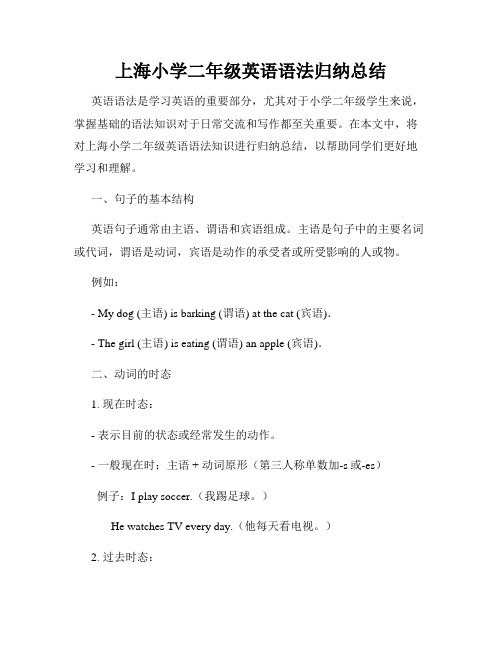
上海小学二年级英语语法归纳总结英语语法是学习英语的重要部分,尤其对于小学二年级学生来说,掌握基础的语法知识对于日常交流和写作都至关重要。
在本文中,将对上海小学二年级英语语法知识进行归纳总结,以帮助同学们更好地学习和理解。
一、句子的基本结构英语句子通常由主语、谓语和宾语组成。
主语是句子中的主要名词或代词,谓语是动词,宾语是动作的承受者或所受影响的人或物。
例如:- My dog (主语) is barking (谓语) at the cat (宾语).- The girl (主语) is eating (谓语) an apple (宾语).二、动词的时态1. 现在时态:- 表示目前的状态或经常发生的动作。
- 一般现在时:主语 + 动词原形(第三人称单数加-s或-es)例子:I play soccer.(我踢足球。
)He watches TV every day.(他每天看电视。
)2. 过去时态:- 表示过去发生的动作或状态。
- 一般过去时:主语 + 动词过去式例子:I played soccer yesterday.(我昨天踢足球了。
)She watched a movie last night.(她昨晚看了一部电影。
)3. 将来时态:- 表示将来要发生的动作或情况。
- 一般将来时:主语 + will + 动词原形例子:I will go to the park tomorrow.(我明天要去公园。
)They will have a party next week.(他们下周要开派对。
)三、名词名词是指人、物、地点或概念。
在句子中一般作为主语、宾语或补语。
1. 可数名词:- 单数形式:一个 + 名词单数形式- 复数形式:两个(几个)+ 名词复数形式例子:There is a cat.(这里有一只猫。
)There are two cats.(这里有两只猫。
)2. 不可数名词:- 通常表示无法具体计数的名词。
二年级英语语法讲解【三篇】

小学二年级英语语法解说【三篇】导读:本文小学二年英法解【三篇】,供参照,假如得很不,迎点和分享。
【篇一】不行数名(复数形式不)bread,r ice,water,juic eetc.略形式I'm=Iamyou're=youareshe's=sheishe's=heis it's=itiswho's=whoiscan't=cannotisn't=is notetca/an abook,apeachanegganhourPreposition:on,in,infrontof,between,nextto,near,beside,at,behind.表示:atsix o'clock,atChristmas,atbreakfast onMondayon15thJulyOnNationalDayintheeveningin Decemberinwinter基数和序数one-first two-secondtwenty-twentiethSome/any Ihavesometoysin mybedroom.Doyouhaveanybrothersorsisters?【篇二】小学二年英法一般去(a)be的去式:I/He/she/itwas(not)⋯.You/we/theywere⋯.一般疑句was,were 放在句首。
b)去式:一定句:Iwatchedcartoons.Shevisitedthez oo.一般疑问句:Didyoureadbooklastnight?Yes,Idid.No,Ididn't.Did sheclean the deskjust now? Yes,shedid. No, shedidn't.否认句:Theydidn'tgothethepartyesterday.Hedidn'tmakemodelshipslastweek.(3)动词过去式的变化:规则动词的变化:Mostverbs+edeg.planted,watered,climbed。
二年级的英语语法知识点

二年级的英语语法知识点在学习英语的过程中,语法是一个非常重要的部分。
掌握了基础的语法知识,学生将能够更好地理解和运用英语。
下面将介绍一些适合二年级学生的英语语法知识点。
一、名词(Nouns)名词是指人、动物、事物、地方等具体或抽象的东西。
在句子中,名词通常用来表示主语、宾语或表语。
名词分为可数名词和不可数名词。
以可数名词为例:单数名词通常加s,复数名词则不加s。
例如:cat(猫)单数,cats(猫)复数。
以不可数名词为例:不可数名词没有复数形式,例如:water(水),milk(牛奶)。
二、动词(Verbs)动词是指表示动作、状态或存在的词语。
在句子中,动词通常用来表示主语的动作或状态。
以动词be为例:be动词有三种形式,分别是am(我是),is(他/她/它是),are(我们/你们/他们是)。
例如:I am a student(我是一名学生)。
以动词do为例:do动词也有三种形式,分别是do(我做),does(他/她/它做),do(我们/你们/他们做)。
例如:He does his homework(他做作业)。
三、形容词(Adjectives)形容词是用来描述名词的特征或性质的词语。
形容词通常位于名词之前。
在句子中,形容词用来修饰名词,使句子更加生动形象。
例如:a big house(一座大房子),a red apple(一个红色的苹果)。
四、副词(Adverbs)副词是修饰动词、形容词或其他副词的词语。
副词可以用来回答疑问词how(如何)。
例如:He runs quickly(他跑得很快)。
五、代词(Pronouns)代词是用来代替名词的词语。
代词可以用来避免重复使用名词,使句子更加简洁。
例如:She is my friend. I like her.(她是我的朋友。
我喜欢她。
)六、冠词(Articles)冠词是指放在名词前面的词语。
冠词分为定冠词和不定冠词。
定冠词有the,不定冠词有a和an。
小学二年级上学期英语语法总结
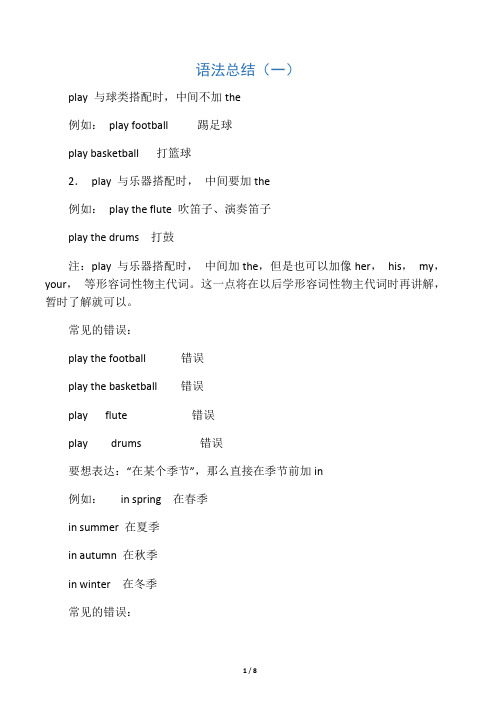
语法总结(一)play 与球类搭配时,中间不加the例如:play football 踢足球play basketball 打篮球2.play 与乐器搭配时,中间要加the例如:play the flute 吹笛子、演奏笛子play the drums 打鼓注:play 与乐器搭配时,中间加the,但是也可以加像her,his,my,your,等形容词性物主代词。
这一点将在以后学形容词性物主代词时再讲解,暂时了解就可以。
常见的错误:play the football 错误play the basketball 错误play flute 错误play drums 错误要想表达:“在某个季节”,那么直接在季节前加in例如:in spring 在春季in summer 在夏季in autumn 在秋季in winter 在冬季常见的错误:in the summer (错误)at winter (错误)at the spring (错误)on autumn (错误)要想表达:“在早、中、晚”,那么用in the 再加上早中晚例如:in the morning 在早晨、在上午in the afternoon 在中午、在下午in the evening 在晚上常见的错误:in morning (错误)at afternoon (错误)in evening (错误)注:night 特殊,要用at例如:at night 在晚上在几点钟前面要用at,无论是整点、半点、还是几点几分,都在时间前直接加at。
例如:at five o’clock 在五点at half past eleven 在十一点半at twelve ten 在十二点十分常见的错误:at the five o’clock 错误in half past ten 错误on the ten o’clock 错误在城市、国家等大地点前面直接加in,并且城市、国家的首字母需要大写。
分享给二年级小朋友的英语语法解析【三篇】

分享给二年级小朋友的英语语法解析【三篇】导读:本文分享给二年级小朋友的英语语法解析【三篇】,仅供参考,如果觉得很不错,欢迎点评和分享。
【篇一】情态动词can(能够),must(必须),may(可以)结构:主语+can/must/may+动词原型He can make the tea.Sally can air the room.We can speak English.Can he make the tea?Can Sally air the room?Can we speak English?He cannot make the tea.Sally cannot air the room.We cannot speak English.Yes, he can. / No, he cannot.Yes, she can. /?No, she cannot.Yes, we can. / No, we cannot.What can you do?注意:情态动词的句子没有第三人称单数的变化,不要在情态动词或动词后面加s。
2)must/have to的区别must 表示必须,是主观上觉得应该做,have to是不得不,是由于客观条件逼迫的必要要做must 只能用在表示现在和将来的句子里,而have to do可以用在任何时态3)must, may, might表示猜测:· must do 表示对现在事实的猜测· must have d one表示对过去事实的猜测· must have been doing 表示对过去正在进行的事实的猜测· may/might do, may/might have done表示没有任何事实依据的猜测,might的可能性更小。
4)can't/couldn't 表示不可能【篇二】人称代词和物主代词1、人称代词主格和宾格的区别:主格通常位于句中第一个动词之前(有时候位于than 之后),宾格一般位于动词或介词之后。
二年级小学生的英语语法
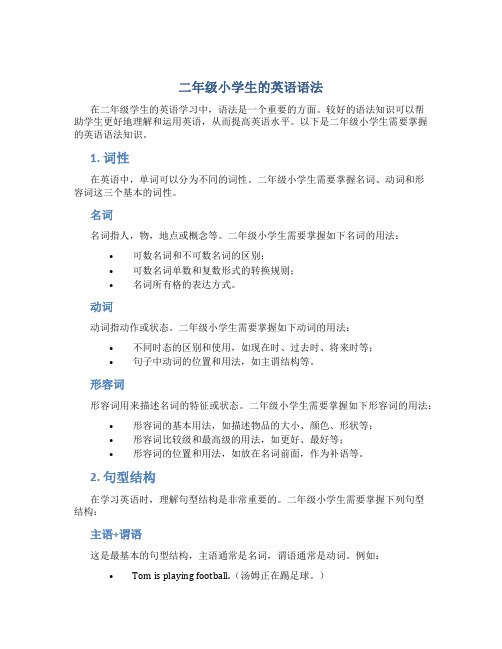
二年级小学生的英语语法在二年级学生的英语学习中,语法是一个重要的方面。
较好的语法知识可以帮助学生更好地理解和运用英语,从而提高英语水平。
以下是二年级小学生需要掌握的英语语法知识。
1. 词性在英语中,单词可以分为不同的词性。
二年级小学生需要掌握名词、动词和形容词这三个基本的词性。
名词名词指人,物,地点或概念等。
二年级小学生需要掌握如下名词的用法:•可数名词和不可数名词的区别;•可数名词单数和复数形式的转换规则;•名词所有格的表达方式。
动词动词指动作或状态。
二年级小学生需要掌握如下动词的用法:•不同时态的区别和使用,如现在时、过去时、将来时等;•句子中动词的位置和用法,如主谓结构等。
形容词形容词用来描述名词的特征或状态。
二年级小学生需要掌握如下形容词的用法:•形容词的基本用法,如描述物品的大小、颜色、形状等;•形容词比较级和最高级的用法,如更好、最好等;•形容词的位置和用法,如放在名词前面,作为补语等。
2. 句型结构在学习英语时,理解句型结构是非常重要的。
二年级小学生需要掌握下列句型结构:主语+谓语这是最基本的句型结构,主语通常是名词,谓语通常是动词。
例如:•Tom is playing football.(汤姆正在踢足球。
)•I like apples.(我喜欢苹果。
)主语+谓语+宾语这个结构比上一个例子多了一个宾语。
宾语通常是名词或代词。
例如:•She is drinking water.(她正在喝水。
)•He loves his dog.(他爱他的狗。
)主语+谓语+间接宾语+直接宾语这个句型结构里有两个宾语,一个是间接宾语,一个是直接宾语。
例如:•My dad bought me a gift.(我爸爸给我买了一份礼物。
)•She gave him a book.(她给他一本书。
)3. 时态英语中有很多时态,每种时态都用于不同的情况。
在二年级的学习中,需要掌握如下两个基本时态。
现在时现在时表示现在的状态或动作。
英语小学生二年级的语法大全
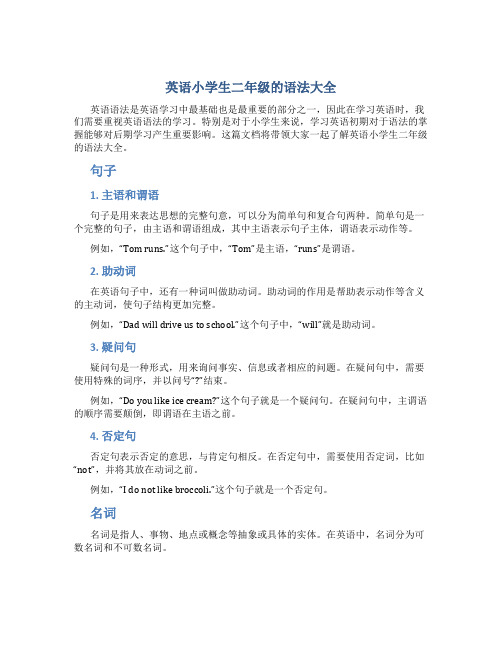
英语小学生二年级的语法大全英语语法是英语学习中最基础也是最重要的部分之一,因此在学习英语时,我们需要重视英语语法的学习。
特别是对于小学生来说,学习英语初期对于语法的掌握能够对后期学习产生重要影响。
这篇文档将带领大家一起了解英语小学生二年级的语法大全。
句子1. 主语和谓语句子是用来表达思想的完整句意,可以分为简单句和复合句两种。
简单句是一个完整的句子,由主语和谓语组成,其中主语表示句子主体,谓语表示动作等。
例如,“Tom runs.”这个句子中,“Tom”是主语,“runs”是谓语。
2. 助动词在英语句子中,还有一种词叫做助动词。
助动词的作用是帮助表示动作等含义的主动词,使句子结构更加完整。
例如,“Dad will drive us to school.”这个句子中,“will”就是助动词。
3. 疑问句疑问句是一种形式,用来询问事实、信息或者相应的问题。
在疑问句中,需要使用特殊的词序,并以问号“?”结束。
例如,“Do you like ice cream?”这个句子就是一个疑问句。
在疑问句中,主谓语的顺序需要颠倒,即谓语在主语之前。
4. 否定句否定句表示否定的意思,与肯定句相反。
在否定句中,需要使用否定词,比如“not”,并将其放在动词之前。
例如,“I do not like broccoli.”这个句子就是一个否定句。
名词名词是指人、事物、地点或概念等抽象或具体的实体。
在英语中,名词分为可数名词和不可数名词。
可数名词可以用来计数,其形式可以单数或者复数。
例如,“apple”这个单数名词在复数形式中变为“apples”。
2. 不可数名词不可数名词不能够用来计数,其数量通常无法准确地知晓。
例如,“milk”这个名词就是不可数名词。
3. 物主代词物主代词用于表示某个人或物所拥有的对象。
在英语中,物主代词包括“my”、“your”、“his/her/its”等。
例如,“This is my book.”这个句子中,“my”就是物主代词。
小学语法总结全集英语(7篇)

1:“first”是序数词,与“the”相连,解释为第一。
2:像“first,term,world”作为词组出现时前面要加“the”。
3:“all”所有;后面的可数名词用复数形式,be动词用“are”。
4:“any”一些;用在否定句和一般疑问句中,与“some”同义。
“some”用在肯定句中。
5:there be+数词,采用“就近原则”。
6:a map of China 与 a map of the world 要牢记。
7:要用“on the wall”,不能用“in the wall”。
门、窗在墙上才能用“in the wall”。
8:can 后+动词原形。
9:play+the+乐器; play+球类;10:like的用法11:动词变动名词形式方法:A--直接在动词后面+ing形式(大多数)。
B--以不发音的“e”结尾的,要去掉e后再+ing,比如:dancing,making,riding。
C--重读be音节,末尾只有一个辅音,须双写末尾的字母后再+ing,如:running,swimmi ng,sitting,putting。
12:现在进行时的构成:be动词+动词ing形式。
标志:now、look、listen、its time to。
13:现在进行时的一般疑问句 /问--be动词+人称+时态(动词ing)答--Yes,he/She/it is/am/are. No,he/She/it isnt/arent/am not.14:用Are you...? Yes,I am/ we are. No,Im not/We arent.15: 动词后+人称宾格形式.16:一般现在时的构成:第三人称单数(三单)。
要注意:后面的动词+s或es。
特例:have→has do→dose go→goes; 标志:often,usually。
17:有些名词变动词时要变形式,例如:teacher→teach;driver→drive.1.一般现在时一般现在时态中,动词一般用原形。
小学英语语法总结2篇
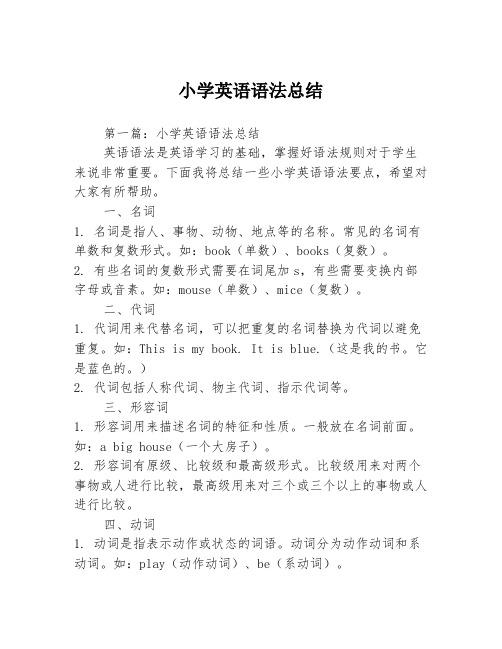
小学英语语法总结第一篇:小学英语语法总结英语语法是英语学习的基础,掌握好语法规则对于学生来说非常重要。
下面我将总结一些小学英语语法要点,希望对大家有所帮助。
一、名词1. 名词是指人、事物、动物、地点等的名称。
常见的名词有单数和复数形式。
如:book(单数)、books(复数)。
2. 有些名词的复数形式需要在词尾加s,有些需要变换内部字母或音素。
如:mouse(单数)、mice(复数)。
二、代词1. 代词用来代替名词,可以把重复的名词替换为代词以避免重复。
如:This is my book. It is blue.(这是我的书。
它是蓝色的。
)2. 代词包括人称代词、物主代词、指示代词等。
三、形容词1. 形容词用来描述名词的特征和性质。
一般放在名词前面。
如:a big house(一个大房子)。
2. 形容词有原级、比较级和最高级形式。
比较级用来对两个事物或人进行比较,最高级用来对三个或三个以上的事物或人进行比较。
四、动词1. 动词是指表示动作或状态的词语。
动词分为动作动词和系动词。
如:play(动作动词)、be(系动词)。
2. 动词有不同的时态形式,如一般现在时、一般过去时和一般将来时等。
五、形容词和副词1. 形容词用来描述名词,而副词则用来描述动词、形容词或其他副词。
如:She sings beautifully.(她唱得很好听。
)2. 形容词通常加-ly后变成副词的形式。
如:quick(形容词)→quickly(副词)。
六、冠词1. 冠词用来修饰名词,分为不定冠词(a/an)和定冠词(the)。
2. 不定冠词用于表示泛指,定冠词用于表示特指。
七、介词1. 介词用来表示时间、地点、原因、手段等关系。
如:in (在)、on(在...上)、with(用)。
2. 介词通常位于名词或代词之前。
这些是小学英语语法的一些基本要点,希望能给大家提供帮助和指导。
接下来是第二篇的内容,请继续阅读。
第二篇:小学英语语法总结八、形式代词1. 形式代词用来指示事物或人的位置、距离或顺序。
小学二年级英语语法知识点三篇分享

小学二年级英语语法知识点三篇分享【导语】语法就是语言的规律。
任何一种语言都有其内在逻辑性(logic)和规律(discipline)。
学习一些基本的英语语法,对于快速掌控英语语言的规律,具有事半功倍的作用,特别是对于一些为考试而编的语法题句的知道,很有作用。
以下是作者整理的相干资料,期望对您有所帮助!【篇一】语态有两种:主动语态和被动语态。
主语是动作的发出者为主动语态:主语是动作的接受者为被动语态。
1) 若宾语补足语是不带to 的不定式,变为被动语态时,该不定式前要加"to"。
此类动词为感官动词。
feel, hear, help, listen to, look at, make, observe, see, notice, watchThe teacher made me go out of the classroom。
--> I was made to go out of the classroom (by the teacher)。
We saw him play football on the playground。
--> He was seen to play football on the playground。
2) 情态动词+ be +过去分词,构成被动语态。
Coal can be used to produce electricity for agriculture and industry。
【篇二】(1) Basic form: am/are/is(2) 肯定和否定句 I am(not) from London.My eyes are(not) small.My hair is(not) long.(3)一样疑问句: Am I a Chniese? Yes, you are. No, you aren't.Are they American? Yes, they are. No, they aren't.Is the cat fat? Yes, it is. No, it isn't.【篇三】一、名词作主语David arrived last night.大卫昨晚到达。
小学二年级英语语法知识点【三篇】

小学二年级英语语法知识点【三篇】导读:本文小学二年级英语语法知识点【三篇】,仅供参考,如果觉得很不错,欢迎点评和分享。
一般将来时一般将来时主要用于:表示将要发生的动作或情况e.g. Tom will have a bike of his own.与这个时态连用的时间状语常用:tonight, tomorrow, the day after tomorrow, next week, in three hours, two days later 等。
一般将来时态与其它结构表将来情况的区别:一般将来时态:主要从时间的角度表将要发生的动作或情况。
be going to 结构:①表(主观上)打算或准备做某事时。
②表有发生某事的预兆时。
e.g. They are going to have a competition with us in studies. It is going to rain.据以上区别,故下面一句是错的:I am going to be eighteen years old next year.应改为:I shall be eighteen years old next year.be about to do sth 结构:意为"刚要做某事"、"马上要做某事"强调时间之紧迫性。
e.g. We are about to discuss this problem. 不规则动词的过去式变化规律sit —— sat throw —— threw am, is —— wasdrink —— drank draw —— drew are —— weresing —— sang fly ——flew do ——didbegin ——began grow ——grew have, has ——hadswim ——swam put ——put may ——mightgive ——gave cut ——cut can ——couldring ——rang let ——letshall ——shouldrun ——ran read ——read will ——wouldride ——rode catch ——caught go ——wentwrite ——wrote teach ——taught eat ——atedrive ——drove think —— thought hear —— heardkeep —— kept buy ——bought see ——sawsleep ——slept fight ——fought find ——foundsweep ——swept hold ——held wear ——worefeel ——felt tell ——told meet ——metcome ——came get ——got mean ——meantbecome ——became make ——made speak ——spoketake ——took say ——said1)is, am -was are-were2) begin-began ring-rang drink-drank swim-swam give-gavesing-sang sit-sat run-ran have-had make-madecome-came eat-ate3) write-wrote ride-rode speak-spoke drive-drove stand-stoodtell-told win-won get-got take-took4) sleep-slept sweep-swept feel-felt keep-keptspell-spelt spend-spent bend-bentmeet-met go-went5) know-knew fly-flew blow-blew grow-grewthrow-threw draw-drew (glow-glowed)6) teach-taught catch-caught buy-boughtfight-fought think-thought7) find-found hear-heard say-said lie-laysee-saw learn-learnt mean-meant8) put-put read-read cut-cut let-let 规则动词的过去式词尾读音a.在浊辅音和元音后读[d],如lived, watered, listened, played。
- 1、下载文档前请自行甄别文档内容的完整性,平台不提供额外的编辑、内容补充、找答案等附加服务。
- 2、"仅部分预览"的文档,不可在线预览部分如存在完整性等问题,可反馈申请退款(可完整预览的文档不适用该条件!)。
- 3、如文档侵犯您的权益,请联系客服反馈,我们会尽快为您处理(人工客服工作时间:9:00-18:30)。
小学二年级英语语法讲解【三篇】
导读:本文小学二年级英语语法讲解【三篇】,仅供参考,如果觉得很不错,欢迎点评和分享。
【篇一】不可数名词(单复数形式不变) bread, rice, water ,juice etc. 缩略形式I'm = I am you're = you are she's = she is he's = he is it's = it is who's =who is can't =can not isn't=is not etc a/an a book, a peach an egg an hour Preposition: on, in ,in front of, between, next to, near, beside, at, behind. 表示时间:at six o'clock, at Christmas, at breakfast on Monday on 15th July On National Day in the evening in December in winter 基数词和序数词one - first two-second twenty-twentieth Some /any I have some toys in my bedroom. Do you have any brothers or sisters? 【篇二】小学二年级英语语法一般过去时态
(a)be 动词的过去式:
I/He/she/it was(not)…. You/we/they were….
一般疑问句was, were 放在句首。
(b)动词过去式:
肯定句:I watched cartoons.
She visited the zoo.
一般疑问句:Did you read book last night? Yes, I did. No, I didn't.
Did she clean the desk just now? Yes, she did. No, she didn't.
否定句:They didn't go the the part yesterday.
He didn't make model ships last week.
(3)动词过去式的变化:
规则动词的变化:
Most verbs +ed eg. planted,watered,climbed。
Verbs ending in e +d eg liked。
Verbs ending in a consonant +y --y +ied eg : study-studied
Short verbs ending in a vowel + a consonant eg: stop --stopped
不规则动词的变化:
is/am-was,are-were,do-did,have/has-had,make-made,fly-flew /u:/
eat-ate,take-took,run-ran,sing-sang,drink-drank 等等【篇三】小学二年级英语语法一般现在时
通常用"usually, often, every day, sometimes"。
肯定句:
I go to school on foot every day.
She goes to school on foot every day.
一般疑问句:
Do you jump high? Yes, I do. / No, I don't.
Does he jump high? Yes, he does. / No, he doesn't. 否定句:We don't go to school on Sundays.
My mother doesn't like watching TV in the evening.。
